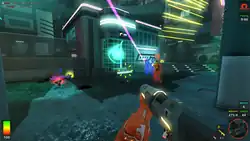Red Eclipse
Red Eclipse is an open-source first-person shooter that is forked from Cube 2: Sauerbraten.[2] Like the original Cube 2, it features multiplayer gameplay as well as in-game level editing, but with improved graphics and a focus on parkour movement. The game is free and open-source software, released under the zlib license, and developed by an open community of contributors. Its content is free, and released under a CC BY-SA license.[3]
| Red Eclipse | |
|---|---|
.png.webp) | |
| Developer(s) | Quinton Reeves, Lee Salzman, various contributors[1] |
| Platform(s) | Microsoft Windows, Linux, macOS |
| Release | March 15, 2011 |
| Genre(s) | First-person shooter |
| Mode(s) | Single-player, multiplayer |
Gameplay

Red Eclipse is a multiplayer first-person arena shooter, similar to Cube 2: Sauerbraten, with a style of play comparable to Quake III Arena or Unreal Tournament.[4][5] Players fight in two randomly assigned teams — Alpha (Blue) and Omega (Red) — which can be changed with mutators. Game modes include: Deathmatch (kill to score), Capture the Flag, Defend and Control (players must secure control points to win), Bomber Ball (a bomb must be brought into the enemy goal before it explodes), Race (players compete for the number of laps), as well as online cooperative map editing. As in Cube 2, each mode can be further modified with several mutators, such as FFA (Free-For-All, i.e. players fight for themselves) and Instagib (all hits are lethal, and players spawn only with a rifle).[4][6][7] Unlike Cube 2, Red Eclipse features parkour movement, such as vaulting or running along walls.[8][9]
Development
Red Eclipse was branched from the defunct Blood Frontier project, itself a fork of Cube 2: Sauerbraten that began development in 2007.[3][10][11] The first stable release of Red Eclipse, version 1.0 ("Ides Edition"), debuted on March 15, 2011.[8][12] The game engine is written in C++ and uses SDL with OpenGL as its cross-platform graphics API. It builds and expands upon established concepts of Cube 2, and uses the same octree geometry model to enable real-time, WYSIWYG editing.[7] Red Eclipse 1.3 in 2012 introduced two new modes: "King of the Hill" and "Coop".[9][13]
Version 1.6, released on December 21, 2017 and dubbed "Sunset Edition", was the last version to use the old rendering engine, before the game started using parts of the engine of Tesseract (another fork of Cube 2) for the next major release. Tesseract's graphical improvements allowed Red Eclipse to use more advanced rendering and lighting techniques — most notably deferred shading, better shadow-mapping, and support for reflection and refraction.[14][15] Red Eclipse 2.0 ("Jupiter Edition"), the first version to use the new engine, was released on Steam in December 2019.[15]
Reception
In 2013, Red Eclipse was used by researchers of the University of Illinois at Urbana-Champaign and Microsoft Research for the creation of IllumiRoom, a project to create an augmented television screen with projectors.[16][17] The researchers noted in their IllumiRoom paper for the CHI 2013 that access to Red Eclipse's source code enabled a "rich, interactive experience".[18]
References
- Red Eclipse Team (2020). "Red Eclipse Credits/Authors". GitHub. Retrieved May 28, 2020.
- Sharma, Mayank (May 2013). "Steam on Linux: everything you need to know". TechRadar. Retrieved 2020-06-01.
Another well known engine is Cube, which is used in Cube 2: Sauerbraten and Red Eclipse.
- "Red Eclipse: Documentation - FAQ". www.redeclipse.net. Retrieved 2020-05-29.
- Williams, Mike. "Red Eclipse 1.5.6 - Games - Downloads". Macworld UK. Retrieved 2020-06-01.
- "Review: Red Eclipse – An open source fast-paced classic shooter -". Linux Game Consortium. 2012-01-28. Retrieved 2020-06-01.
- "Red Eclipse: Documentation - Modes and Mutators". www.redeclipse.net. Retrieved 2021-02-26.
- Hampton, Tavis J. (13 April 2011). "A Review of Red Eclipse, Free and Open Source FPS". Make Tech Easier. Retrieved 2021-03-05.
One of the most unique and promising features of Red Eclipse is the Editor. It already features a good number of maps, and users can create their own with an in-game editor. This means that you can literally walk around in your world as you create it. This is a feature of the Cube Engine 2, which makes switching back and forth between editing and testing a matter of keystrokes.
- "Free, open source FPS 'Red Eclipse' hits version 1.0". Joystiq. Archived from the original on 2015-02-26. Retrieved 2020-07-06.
- Dubowy, Liane M. (2012-09-11). "Red Eclipse: Neue Version des Open-Source-Shooters". heise online (in German). Retrieved 2020-07-06.
- Larabel, Michael (2009-02-01). "Blood Frontier: The Latest Open-Source FPS - Phoronix". www.phoronix.com. Retrieved 2020-06-02.
- "Blood Frontier: ingyenesen letölthető!". GameStar (in Hungarian). 2009-12-19. Retrieved 2020-07-06.
- Rossignol, Jim (2011-03-20). "Red Eclipse, An Open Source FPS". Rock, Paper, Shotgun. Retrieved 2020-07-06.
- "Open-Source-Shooter "Red Eclipse" in neuer Version - derStandard.at". DER STANDARD (in Austrian German). 2012-09-13. Retrieved 2020-07-06.
- "Cube 2's Tesseract Vastly Improves Graphics - Phoronix". www.phoronix.com. Retrieved 2021-01-25.
- "Free and open source arena FPS 'Red Eclipse 2' is now out on Steam". GamingOnLinux. 20 December 2019. Retrieved 2021-02-26.
- Warren, Tom (2013-04-29). "Microsoft IllumiRoom is a coffee table projector designed for the next-generation Xbox". The Verge. Retrieved 2020-07-06.
- "IllumiRoom: Peripheral Projected Illusions for Interactive Experiences". Microsoft Research. Retrieved 2020-07-06.
- Jones, Brett; Benko, Hrvoje; Ofek, Eyal; Wilson, Andrew D. (2013-04-27). "IllumiRoom: Peripheral Projected Illusions for Interactive Experiences": 869–878. doi:10.1145/2470654.2466112. S2CID 16951236.
The majority of the illusions were paired with an open-source first-person shooter (Red Eclipse). This created a rich, interactive experience, enabled by access to source code.
{{cite journal}}: Cite journal requires|journal=(help)